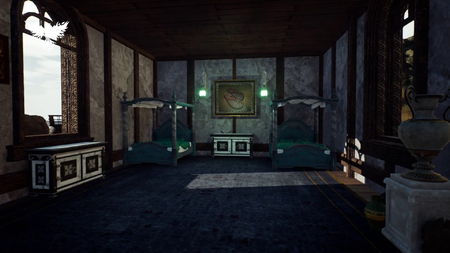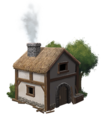Player housing
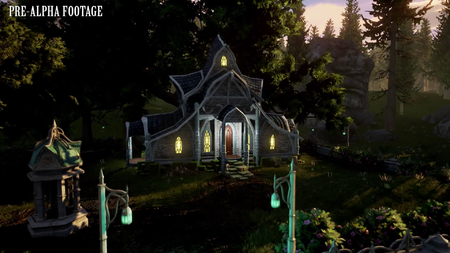
Players will have the ability to survey and develop land anywhere in the world. Be a pioneer deep in the wilderness, build the home of your dreams, and work the land to cultivate resources and supplies. Alternatively, stick with civilization and safety in numbers – purchase a home within the confines of a village and watch your investment grow as that village turns into a city. Homeowners in our game will have the ability to develop their plot of land as they see fit. Focus on farming, animal husbandry, or own your very own smithy. You’ll be able to specialize your land to maximize your profits or your comfort – be sure to choose wisely.[2]
Player housing is player-owned accommodation in the form of Apartments, Freeholds, Inns, and Static housing.[4][5]
A player may own up to one of each type of housing simultaneously.[6][7] Static housing and Apartments are one per server; Freeholds are one per account.[8]
| Player housing | Type. | Availability. | Starting count. | Limit. |
|---|---|---|---|---|
| Apartments | Instanced.[5] | Village stage and higher.[9] | 50.[10] | One per character per server.[8] |
| Freeholds | Open world.[5] | Village stage and higher.[5] | Low thousands per server.[11][12] | One per account.[8] |
| Inns | Instanced.[13] | Starting areas and Nodes.[4] | Most accessible.[4] | - |
| Static housing | In-node.[5] | Village stage and higher.[5] | 8.[10] | One per character per server.[8] |
- If you were to think about the level of exclusivity between the different types of housing that we have, obviously the most exclusive when it comes to a quantity is going to be Freeholds, followed by In-node housing, followed by Apartments, then followed by Inns.[14] – Steven Sharif
- Q: Freeholds specifically are locked one per account?
- A: Correct.[8] – Steven Sharif
- Q: If I put an alt on a different server I could have in-node housing or at least an instanced house?
- A: Correct, yes.[8] – Steven Sharif
Benefits
Player housing offers a number of benefits.[15][16]
- Ability to claim citizenship to a node.[17][18][19]
- Additional benefits are granted to home owners who are also citizens of that node.[20]
- Ability to place furniture and other decor items.[21][22][23]
- Houses will be empty when purchased. Players will need to place furnishings and decorations in them.[24]
- Each size of player-owned housing determines how many decor items can be placed in it.[15]
- Storage containers.[23][16]
Each different type of housing offers different additional benefits.[20]
- Apartment benefits include placement of pots to grow seeds and other functional furniture items.[25]
- Freehold benefits include the ability to place business and artisan buildings.[26][22][16]
- Static housing benefits include garden sections for farming special types of crops.[27][28][22]
- Players may grow crops in the garden sections of freeholds or static houses.[25][28][22][29]
- Crafting benches are available in freeholds and static houses but not apartments.[25][22][16]
- Prized items can be displayed within a house.[16]
- Achievements and trophies may be displayed.[16]
- Social activities.[16]
- Housing may provide proximity based bonuses.[16]
Citizenship
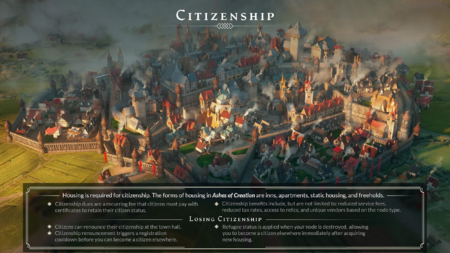
Citizenship is, aside from nodes existing, one of the most important parts. So you as a player will get to become a citizen of these nodes: you're going to need to acquire some form of housing to be able to do that within that node's jurisdiction, it's zone of influence.[4] – Chris Justo
Player housing grants the ability to claim citizenship of a Village (stage 3) node or higher.[30][4][17][18][19] Gaining citizenship through player housing is not automatic. It must be claimed.[17]
- There is not a hard cap to node citizenship, but there is a soft cap. Citizens pay dues and property taxes based on the stage of the node when the player became a citizen.[30][4][17][31][32]
- When you become a citizen you enter in at a certain citizenship due structure; and citizens pay taxes to their node in the form of both property taxes based on what type housing as well as citizenship dues, which are necessary. And as you enter later into the stage of a node's development, you will pay a higher value on the citizenship dues or vice-versa: if you own a property later, you will be entered into a property tax that is higher based on where you enter that property ownership within the node's history. So those help to form a soft cap. Now, if payers are willing to pay more to be a citizen of a particular node, they have that option, but at some point it becomes restrictive.[32]
- You can declare citizenship to only one node and when you declare that citizenship. Let's say for example, one guild perhaps wanting to take all their members and have them all declare the same citizenship to a location. The longer a node exists the higher the prize it is to take and some systems with regards to crafting progression and/or rewards and bonuses or the reliquary that we haven't really touched on a lot, those systems are going to be so enticing that from an incentive standpoint it will compel other groups to either potentially break alliances or siege the city in order to take the goods that are potentially in it. So, from an incentive standpoint we have that at play. Additionally, we don't have a cap per-se that we've announced yet on the citizenship aspect of being in a node, but we do have soft caps. It becomes costlier the higher number of citizens each time one new person wants to join to be part of a node. So, there is sort of a soft cap on how many citizens one node can have and it might be that not all in the guild can participate in that area. So, there's a natural divide: A pseudo faction, so to speak between who is a part of that node and who is not.[32] – Steven Sharif
- Your account is bound to one declared citizenship per server, which means that if you have two alts and your main character on one server you may only be a citizen of one node between those three... If you have an alt on a different server, it could be a citizen of a node as well.[36] – Steven Sharif
- Players lose their node citizenship after their node is destroyed in a node siege without entering into a cooldown period.[37][34][38]
- Apart from node destruction, there is no player driven system that can strip another player of their node citizenship.[39]
- Node citizenship is not tied to membership of a guild. Guilds don't "own" nodes.[34]
- Players can interact with the node board to get a list of citizens of the node. Clicking on a citizen will reveal information about their guild, society, religion, and property ownership.[40]
- Citizenship tickets may also grant citizenship to certain node stages. This mechanic will be decided based on testing.[41]
- A player does not need to declare citizenship of any node. These players won't need to pay taxes but will miss out on benefits of citizenship.[42]
Household security
A permissions system will enable an owner/primary tenant to grant access to specific parts of their housing.[13][43][44][45]
- Ability to open the door and enter the home.[46][44][45]
- Access to crops.[47][44]
- Ability to deposit or withdraw items from storage containers.[48][46][44][49][50]
- Permission to use furniture or crafting stations.[46]
A property has a single owner/primary tenant.[13][51][43]
- Marriage enables family size to increase by one so that housing access can be shared.[51][52]
- Access lists can be used to mimic co-ownership.[45]
- Payment of taxes may be via a "gentleman's agreement".[53]
- It'll be a single owner based system for those types of properties- for properties in general, but it doesn't prevent players obviously from collaborating and pooling resources in order to achieve certain achievements in the game.[43] – Steven Sharif
Player housing/safe zones
- Players cannot PvP while inside the footprint of a "home area" of player housing. This includes freehold homesteads, instanced apartments, and inns.[54][55][56]
- Currently the plan is when you're on the footprint of a home, you can't be damaged by other players. Like all things that are a work in progress, this can change... which ties to your other question. Where specifically PvP can or can't happen isn't a core pillar. For example, when we said while on the footprint of your home building on a Freehold that you can't be harmed by other players, this doesn't change a core pillar of the game. Alpha Two will be significant moment for us to test, to get feedback, and iterate on things.[55] – Ry Schueller
- Players are not able to be attacked or robbed while occupying their player stall inside the limits of a node.[60]
- Q: Does 'home' also mean apartment or in-node house?
- A: Home is the "home area" of player housing. Instanced apartments and inns are player housing.[54] – Ry Schueller
Apartments
Apartments provide instanced player housing functionality on a rental basis.[61][5]
- Village (stage 3) apartment buildings offer 50 rental apartments. Additional apartments can be added at Town (stage 4) if the mayor chooses to construct them and if there is an available plot for the expansion. This includes different types of apartments, such as penthouses.[30][4][61][10][5]
- The number and sizes of available apartments increases as a normal part of node advancement.[61][9]
- It is estimated that the number of apartments available in a Metropolis (stage 6) node will be in the hundreds, if that node specs into all apartment expansion upgrades. This number is subject to change based on testing.[61]
- Prices for apartments will fluctuate depending on the number of units already sold in the node.[5]
- Different price points offer different apartment sizes and types, such as penthouses.[4][5]
- It was previously stated that apartments would be available at Town (stage 4) or above.[5]
- The mayor may additionally construct apartment buildings when the node hits stage 4 at one of the building plots in the node, along with cities gaining additional static housing and apartments by default as a normal part of the leveling process.[9] – Steven Sharif
Freeholds

Three main purposes that freeholds provide are allowing players an opportunity to express themselves in a highly customizable fashion. So these are plots of lands that you have access to. You can build different types of buildings on. You can create housing and place furniture; and you can grow livestock and you can just own this piece of land. And one unique thing about allowing the players express themselves through this manner in Ashes of Creation is that it's in the open-world, so it's not an instance or a phase location that you are customizing. You're actually leaving a mark on the world that's representative of you as a player, as a character. Something you can you can roleplay. But importantly enough, when it comes to the economy, freeholds also provide the highest level of processing that's available; and processing is one of three primary branches that exist within the artisanship system. Processing is the intermediary step between what you gather in the wild and what you eventually craft via recipes. The the other primary purpose of freeholds is that they allow you to offer certain types of business services, because we don't just want to make freeholds delegated to the individual owner. We want it to have capabilities to interact with other players as they're walking past your freehold- as they're going to these hunting grounds and participating in quests or events that might be existing around; and that means that location matters for the freehold, because it's important to the business.[63] – Steven Sharif
We got some sheep; we got some cows and pigs; and we got some chickens back there; and we have a lot of space for different farmables. So we have a wheat here, corn, and then tomatoes over there as well.[64] – John Collins
Freeholds are sizable player housing plots that can be situated in baronies within the Zone of influence (ZOI) of a Village (stage 3) or higher node, including the ZOI of any of its vassal nodes.[11][65][66][26][67][68][69][5]
- Freehold estates may be purchased from other players,[70] or can be obtained via deeds from completing a quest and winning an auction.[11][65][66][71][26][67][72][69]
- Freehold ownership, whether purchased from players or via a freehold auction, requires the purchaser to have completed a freehold quest, which has a level requirement of 50.[73][74][11][75]
- The seller decides if their freehold should be auctioned or sold directly to other players.[76]
- Some freehold auctions will require node-type-specific bound currencies, others will auction for gold.[77][78][79] This is intended to cater to players with different playstyles, who are progressing through alternate systems.[77][79]
- The idea is that we're not reserving freeholds for the top 10 percent of levelers, we're reserving freeholds for the top 10 percent across the multiple different play paths that exist within the game; and this spreads out that ownership across different playstyles.[77] – Steven Sharif
- Housing takes several forms in the world of Verra. However, Freeholds are the highest tier of player housing available. Acquiring a Freehold is a major accomplishment, and it will take a large amount of effort and strategy to get a Freehold of your own. Since there is a limited amount of space available to place Freeholds in each node’s region, these are symbols of prestige for those who are able to acquire and maintain their Freeholds.[11]
- Freeholds are approximately 1.5 acres in size, or roughly 100m x 60m.[65]
- The footprint of a freehold does not change with node progression.[80]
- Previously it was stated that freeholds were half an acre in size.[81]
- The developers are expecting the number of freehold plots on each server to be in "the low thousands" depending on world state.[11][12][82][83]
- The number of Freeholds on a server will vary on a number of factors, such as how player actions advance nodes. At the moment we are targeting the low thousands for Freeholds on a server, but as we continue to test these systems during Alpha Two, we anticipate making adjustments.[11]
- Freeholds are subject to node taxes.[84]
- Freehold tax is calculated based on the number of permits issued for buildings on a freehold.[84]
- Freehold buildings that require permits will have additional upkeep costs.[11]
- Blueprints are required for the construction of the freehold buildings that are used to process resources into crafting materials.[85][86][87][88][89]
- The best processing can only be carried out on freeholds, so obtaining a freehold will require a large amount of effort.[90]
- If a player wants to achieve a freehold they can achieve the freehold, however the amount of effort resources and time that's required in order to achieve that freehold is a large amount. It is something that is a monumental achievement for you to to get that freehold; and the reason why is because freeholds tie in very heavily to the processing artisanship aspect. Some processing can be done in nodes, but the best processing is done on freeholds; and we want to make sure that there's a little bit of a throttle or gate on the amount of effort that's necessary to achieve that influence over the processing market.[90] – Steven Sharif
- Inns and other player housing options are available that are easier to obtain for players who do not need the benefits of a freehold.[85]
- Just because the freehold is very difficult to attain doesn't mean that you don't have a space for housing and furniture that you can achieve through our apartment system or an inn or the static in-node housing. Those are alternate methods as well but they do not have that aspect of the best processing is done on the freehold.[85] – Steven Sharif
- Freeholds are intended to work with the family system.[91]
- The spread of corruption in the world does not impact the freehold system.[93]
- Players are not able to adjust the terrain of their freeholds. Sloped terrain will result in stilts beneath placeable structures (to keep them level).[94]
- Expansions and upgrades become available as node progression allows.[81]
Freehold placement

There'll be a variety of predetermined parcels of land in each node's zone of influence; and once players acquire their freehold permit they'll be able to lay claim to any available parcel in the issuing node's region so- and by region we mean... the total combined territory of a node and all of its vassal nodes. So, if you acquire a freehold permit in the metropolis of a huge region, almost 20% of the map, you'll be able to lay a claim to an available parcel anywhere within that region. So it gives you a lot of freedom if you're able to acquire the permit from a metropolis.[66] – John Collins
Freehold plots require a bound deed (permit/certificate) from the parent Village (stage 3) or higher node in order to place the plot.[11][71][26][67][72][69]
- Freehold deeds are obtained through completion of a Lord's quest to ascertain worthiness for lordship over an estate.[95][66][71][26][67][72][69]
- That was for a time a lively debate on our design team about whether or not there should be a level gate essentially from even preventing the potential for ownership. The reason why I chose to keep it at level 50 for now is because there are alternate systems that provide access at lower levels through permission setting. So it's one thing to own the home, it's is another thing to access the contents and to continue progression. Let's say, in the processing profession, you might want to gain mastery in: that mastery process leaves the nodes at around level 30 in the leveling experience for a processing profession; and so one of the debates on the design team was whether or not we should reduce the level requirement down to level 30 so that there's a seamless transition from node-based processing progression and the Freehold capability of progression.[73] – Steven Sharif
- Deeds may only be used to place a freehold if the deed holder successfully wins a freehold auction for an estate.[11][97]
- You're going to see a little bit of change and this is one of the first ones: that these are predetermined locations that exist around the node or under its vassal structure that you will have the ability to bid on; and to give you a sense there, this allows us to customize a bit of those predetermined parcels, like a Sherwood Forest type of example.[66] – Steven Sharif
- A deed holder who has won an estate auction may then claim the estate from within a barony in that node's ZOI, including the ZOI of any of its vassal nodes. Placement of the plot is enabled by using the deed item in a player's inventory to get a top-down view of the estate, then selecting the desired location for the plot.[11][97]
- It'll basically be an item in your bag; and once you get to your parcel, you claim that piece of land and then once it's claimed you'll be able to use the item to go into top-down view and layout actually exactly where your freehold will go on that parcel of land. You'll have a lot of freedom, so a lot that will be going through looking at your whole area of land you now own claim to and then deciding where the best spot to put your freehold in there would be.[97] – Kory Rice
- Freehold plots must not be placed in close proximity to any of the following:[11][101][65][97][66][26][67][68][69]
- Collections of freeholds placed in close proximity are still considered part of their parent node and do not become a separate node, other than via roleplay.[108]
- Adjacent freeholds do not share any bonuses with their neighbors, but guild halls owned by partron guilds may confer benefits to surrounding freeholds.[109][105]
Freehold buildings

After you build your house, you can build other buildings on your Freehold. Each building needs the blueprint to start the process. If you have a cosmetic skin you want to use on a building, this is used after placing the blueprint. Once this has been placed, the building will be shown in a non-functional, construction state. Players will need to provide the required materials needed to complete the building construction, for each building on their Freehold. No Freehold has room for every possible option, so players will need to choose how to develop their Freehold by choosing to build specific artisan buildings, business buildings, and creating room for livestock and crops.[11]
Freehold buildings that can be placed on a freehold plot serve three main purposes.[11][26][111][5][112]
Freehold buildings require blueprints and materials to construct.[11][72]
- Sheds are present on empty freehold plots to provide storage for materials needed to construct freehold buildings.[100]
- Some freehold buildings have multiple tiers, with different footprint sizes.[26][80]
- Upgrading a tier will not change the size of the building in terms of footprint, but may increase in height.[80]
- Basements in freehold buildings are to be decided.[114]
Freehold taxes are calculated based on the number of permits issued for buildings on a freehold.[11][115][116][84][117]
- Buildings that require permits will have additional upkeep costs.[11]
Freehold building architecture is based on the blueprint for the building.[26][118]
- Freehold skins are applied to blueprints matching the type of building: housing, artisanship, and business.[11][26][119][120][118][121]
- The freehold building blueprints must be obtained in-game first before the cosmetic can be applied.[118][121][120]
- Players are not locked to the racial appearance of a freehold building blueprint.[122]
- The way we look at it is the freehold is your space so we want you to be able to make it look the way you want it to.[118] – Jeffrey Bard
Freehold building placement

On the left we have some farmable animals- some livestock here in pens; and then we have in the middle there's a bunch of crop rows of farmable crops the players can have; and then there's a couple different examples of different freehold buildings you could have on your freehold: one of which is the house on the right and then some other freehold buildings as well, like it looks like there's a mill in the back there as well.[123] – Kory Rice
Freehold buildings and other items/props can be placed on freehold plots (by the land owner).[111][124][81][5][112]
- Freehold building permits to allow for a specific number and type of buildings to be placed on the freehold plot must be acquired from the node where the freehold deed was obtained.[11][115][116][84][125][117]
- Freehold taxes are calculated based on the number of permits issued for buildings on a freehold.[11][116][84][117]
- Currently freeholds have a combined maximum total of six artisan and business buildings that can be placed in addition to a homestead.[11][126]
- On a Freehold you can have your house, and up to six additional buildings. The additional buildings can be artisan and/or business buildings. Larger buildings may take up more room, reducing the total number of buildings that can be built on a single Freehold.[11]
- Space that is not used for freehold buildings can be utilized for other purposes, such as livestock and crop placements.[125]
- Players can manipulate the orientation of freehold buildings and items being placed on their freehold plot.[99]
- There may be a grid-based system that freehold owners can use to place items/props and buildings on their freehold plot.[124]
- Targeting dummies are planned as placeable props with functional mechanics.[127]
- Players are not able to adjust the terrain of their freeholds. Sloped terrain will result in stilts beneath placeable structures (to keep them level).[94]
Freehold benefits
Freeholds offer the following benefits in addition to other player housing benefits.[26]
- The larger the homestead, the more floors it will have and the more furniture can be placed on the freehold.[11][26]
- Certain furniture may only be able to be placed outside.[26]
- Freehold businesses allow the freehold owner (and authorized individuals) to sell items, consumables and services to players.[128][26][129]
- Freeholds are the only place that master and grandmaster processing is available.[130][26]
- Players can craft up to journeyman level on freeholds.[130][26]
- Lower tier gathering can be done on freehold plots.[131]
Freehold security
Freehold owners are able to set permissions that grant access to their artisan and business buildings' services.[11][132][91][133][26]
- Freehold ownership is designated by one account only and then the family system is the system that facilitates multiple accounts having permission basis within that freehold.[51] – Steven Sharif
- Freehold permissions are intended to work with the family and guild systems.[11][132][91]
- It is still not determined if freehold permissions will be able to be granted to individuals outside those social structures.[132]
- Freehold permissions may only apply to battalions/micro-structures within a guild.[134]
- Interaction with the guild system will be tested in Alpha-2.[135]
- This includes permission to enter the homestead, interact with furniture, access storage, interact with crafting or processing stations, and harvest resources.[11]
- Permissions to help manage your home are handled through affiliations like your Guild and family system. When setting permissions for your Freehold to do things like enter the house, interact with furniture, access Freehold storage, interact with crafting and processing stations, and harvesting gatherables on a Freehold, you can set if your Guild or family members should be able to do these things.[11]
- Permission to decorate a freehold is restricted to the owner of the freehold.[46] Previously it was stated that permission to decorate but not take anything from the house would be able to be assigned to other players.[44]
- Family members may be granted permission to apply their cosmetic skins to freehold buildings.[70]
Players cannot steal from a freehold under normal circumstances.[11][136][47][137]
- Items stored in a freehold become lootable after a successful siege against their parent node.[138][11][137] It has not been decided which players get to loot the debris field during this period.[138]
- Only players given permission to do so will be able to do things like access your Freehold storage, and harvest crops and animals on your Freehold. These permissions are capable of being individually assigned per interaction. Note that if the node associated with your Freehold is successfully destroyed during a siege event, attackers will be able to assault Freeholds, and have a chance to pillage them for their resources.[11]
Players cannot PvP while inside the footprint of a freehold homestead even if the doors are unlocked.[11][56] This does not apply for a period of two hours following a successful siege against its parent node.[57][58][38][59]
- Your home building is safe from PvP. While on the footprint of your home, you can not be harmed by damage from other players.[11]
- NPC guards may be available for hire to defend freeholds after a successful node siege.[59] NPC guards that permanently exist on a freehold are not a planned feature.[139]
- Duels may be initiated within a freehold or node as they are considered self-contained events that are opt-in by all parties, and do not fall under the player flagging system.[140]
Static housing
Static housing provides non-instanced player accommodation within a node, also known as in-node housing.[5]
- Players are able to purchase small one room houses (cottages) starting at the Village (stage 3).[5][10]
- There will be 8 cottages available for purchase at the village stage.[10]
- The amount of static housing increases as a normal part of node advancement.[9]
- The architecture of static housing is predetermined by the racial influence of the node's layout and style.[142]
- Taverns and Player shops are not tied to in-node housing.[20]
Static housing benefits
Static housing offers the following benefits in addition to other player housing benefits.[22]
- Small garden sections for farming special types of crops.[27][28][22]
- Crafting benches.[22][16]
Static housing development
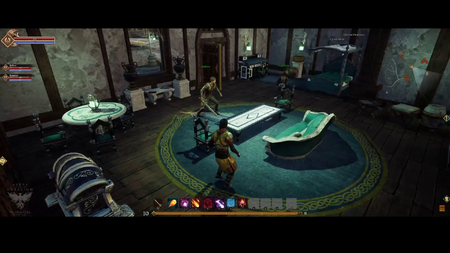
If the node advances players can essentially select an option on their house as they own it that they want it to upgrade to the next stage if the node advances or they can select an option not to upgrade it. So you as the node levels and larger homes become available, the town stage introduces additional medium types housing, the city stage introduces large sized homes, and in the metropolis stage introduces my mansion size houses each of which contain specific... allowances and allotments for different types of furnishings that have gameplay implications.[143] – Steven Sharif
In-node housing can scale in size with the advancement of its parent node. This may be toggled on or off by the player.[143][5]
- The Village stage offers small housing types.[143]
- The Town stage introduces medium housing types.[143]
- The City stage introduces large sized homes.[143]
- The Metropolis stage introduces mansion size houses.[143]
If you choose to keep the same size then the next stage will have an occupied small home. So for instance if at stage three there are 8 small home and you own 1, then at stage 4 there are 10 new small homes of which x are owned by previous owners, and 10 new medium homes of which x are owned by upgraded small home owners.[144] – Steven Sharif
New property becomes available at each stage of advancement, but it will be more akin to what was available at the previous stage.[5]
- Only the houses that existed at the Village stage will become main street mansions at the Metropolis stage.[5]
Housing destructibility
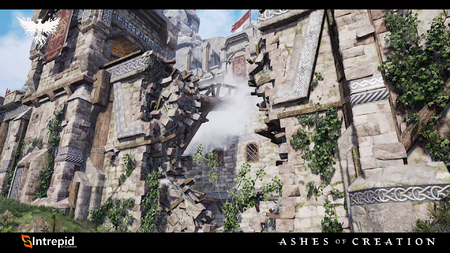
You could be more precision oriented in the decision to attack a city. Let's say it's a rival node that's trying to reach a node stage five or something and you want to disable their ability for the religious system to progress so you target the temple during the attack, or you want to disable their scholars academy from reaching a higher level so that your nodes can; or you want to disable multiple buildings that allow for experience and quests to be undertaken by its citizenship, which prevents them from keeping up in pace of experience gained with your node. These can be more precision oriented and don't have to effectualize an actual takeover of the node.[146] – Steven Sharif
Node buildings (including player housing) have hit points and can be damaged or destroyed by different systems.[147][148]
- NPC-driven events that are a response to story arcs or node atrophy.[147]
- Node sieges and node wars.[147]
- Attackers may not be capable of destroying a node during a siege. Instead they may carry out precision attacks to disable specific service-oriented buildings within the node. These buildings can be targeted with siege weapons and bombs.[146]
- Hazardous events such as tornadoes or hurricanes.[149][147]
- Mayors have the ability to demolish constructed node buildings. This will have a node mandate cost and will require player buy-in via a vote.[30][150]
- Mayors will also have the ability, if they want, to demolish constructed buildings. So if they if they so choose they can destroy a building if they don't think it's needed anymore. But this will have mandate cost and a player buy-in votes. So we want to make sure that [the] mayor can't just go and blow up the whole node if they're trying to grief or something. So this is very important and impactful decision.[30][150] – John Collins
If building maintenance is not paid, or a building is damaged as the result of an event or siege, the building will enter a state of disarray.[30][150] Any NPCs or services offered by that building will not be available until the building is repaired.[151][148]
- Players must contribute materials to repair disarrayed buildings and restore them to an operational state.[30][150][147][148][152]
If a node siege is successful, or if buildings otherwise take significant damage, they are destroyed and appear as rubble on the plot they occupied.[30][150][147]
- Node governments must clear any rubble on plots before any buildings can be reconstructed. Any prerequisites for the building reconstruction must be satisfied beforehand.[147]
- Buildings also live within a prerequisite system. So in order to build down the tech tree of what these buildings provide, as the node grows larger to access stronger building types, you may get a kink in that chain if it's destroyed and you'll have to stand that back up in order to support the service again.[147] – Steven Sharif
- If the node is destroyed by a node siege, the debris field will contain spoils that are lootable by attackers or defenders.[153][154][155][148][156][157]
- Player housing that is destroyed during a node siege can no longer be sold.[158] Furnishing and decorations are retained and can be placed again later.[158][159][160]
Static housing destructibility
Following a node siege, static housing will be scaled back or destroyed based on the advancement of the node.[159]
- If the housing was purchased at a higher advancement than the node currently is then it will be destroyed, otherwise the housing will be scaled back.
Apartment destructibility
Apartments may be destroyed in the following circumstances:[159]
- If their building was destroyed during a node siege, even if the siege was not successful.[152][159]
- If the mayor decides to destroy apartment buildings all items and layouts will be mailed to the owner.[161]
- If a mayor built extra apartment buildings at Town (stage 4) or higher and the Node deleveled below that stage.[159]
Freehold destructibility
Freeholds may be attacked by any player for a period of two hours following a successful siege against its parent node.[57][58][38][59] Freeholds can also be lost by foreclosure for not paying property taxes or other fees.[11]
- Players and their allies may defend their freehold for this period of time.[59]
- Structures and guards may be obtained to defend freeholds during this period.[59]
- When it comes to losing Freeholds like this, one person’s loss is another person’s gain. While there aren’t enough Freeholds in the world for everyone to have one at the same time, this cycle of players losing Freeholds creates opportunities for other players to acquire one.[11]
After the two hour period of open combat following a successful node siege, any remaining freeholds will exist under a grace period for roughly 1 week where another node may take over the zone of influence of the freehold.[58][38]
- The freehold owner will be required to undertake a quest process to have their freehold adopted by a new node if one exists.[58]
- At the end of the grace period, if the freehold does not reside within the ZOI of a Village (stage 3) node or above, it will be destroyed.[11][38][58][162]
- If a siege is successful, then the Node is brought down to Level 0, and anyone who was a citizen of that Node is no longer a citizen. Freeholds within the Zone of Influence are subject to a period of vulnerability. These Freeholds can be destroyed by other players during a period of roughly 2 hours after a successful siege. Destroyed Freeholds are subject to material loss, and blueprints for them are mailed to the player to utilize for future placement in order to allow the player to keep their Freehold’s layout and structure. Once the vulnerability period is complete, any remaining Freeholds will exist under a grace period for roughly 1 week where another Node may take over the Zone of Influence of the Freehold.[38] – Margaret Krohn
- Q: How many times a year do you suspect that most players will be moving residence based on nodes being eliminated from sieges?
- A: There are a lot of variables that influence that answer. I'm not sure I can give an average, but what I would say is that depending on the political dynamic of a server: if a server tends to have more combat and/or sieges against nodes, that is going to increase the amount of opportunity for freeholds to be removed from the world and then replaced. I'm not sure I have an average. what I will say is that it is very important to remember that Ashes is not a PvP game and it is not a PvE game. It is a PvX game and that has a very specific meaning. It means that as these systems are developed as they are designed and they are integrated with each other: they are done so from a competitive viewpoint and how that system relates to both PvE and PvP. Freeholds are one of those systems very much so and it's because of the cyclical nature that we're attempting to achieve with the development of nodes and the destruction of nodes, the world is a rapidly and dynamically changing place really. So it's intended to be something that is constantly recycling and is leaking out different types of content and new content that revitalizes the player interest and stimulates new points of conflict or cooperation.[163] – Steven Sharif
Player housing designs and decorations are retained and can be placed again later if the housing is destroyed during a node siege.[11][159][160]
- Blueprints for homestead, business, and artisan freehold buildings, including progression and upgrades, are returned to the player.[11][38][159][160]
- A possible design idea is for items such as furnishings to be boxed in crates that are accessible inside the new home.[164]
Real estate
Players buy the deeds for housing from the node itself, or may buy and sell properties from other players.[165][15][166][19][5]
- The developers are considering an auction-based method for listing new properties that become available for purchase when a node advances.[167] Currently freeholds may be acquired via auction.[11][65][66][71][26][67]
- Housing will have a base price that scales with the number of citizens in the node.[168]
- There is no cap on the price of player-originated housing sales.[20]
- In-node housing will be at a premium, and is expected to be hotly contested.[5]
- The more apartments that have been purchased in a node, the higher the price scales.[169]
- Player housing that is destroyed during a node siege can no longer be sold.[158]
- Freehold plots may be purchased from and sold to other players,[165][70] or can be obtained via deeds issued by a Village (stage 3) or higher node.[11][65][66][71][26][67][72][69]
- We're establishing a real estate market that players can invest in and then sell within the in-game economy, but also they are a resource that's subject to removal through the sieging system as well, so there's a bit of risk implied there but the idea is that this is something for players to strive for.[70] – Steven Sharif
- Housing ownership can default back to the node if the owner fails to pay their property taxes. A balance and penalties will be charged to the new purchaser of the home in the manner of a "foreclosure process".[168]
- Players will not be able to exceed their allotment of housing in the game.[172]
- Rental and leasing concepts are under consideration.[172]
Taxes
When a node reaches stage 3 (Village) and a player run government has formed, all player housing will pay taxes.[173]
- A player's tax charge will be determined by the number of structures built on their plot.[84][117]
- Freehold taxes are calculated based on the number of permits issued for buildings on a freehold.[11][115][116][84][117]
- Buildings that require permits will have additional upkeep costs.[11]
- Maintaining businesses requires licensing and payments to the node your Freehold is associated with. This permitting system allows for a certain number of buildings to be constructed on a Freehold. Permits can be obtained from the same node the Freehold was certified from, and buildings that require permits will have an additional upkeep cost.[11]
- Housing foreclosures result from failing to pay property taxes or other fees.[11]
Housing foreclosures
Housing foreclosures result from failing to pay property taxes or other fees.[174][11]
- Non-payment of taxes will put the housing into a default status. The player will have a period of time to settle the debt before the housing is foreclosed.[174]
- The developers are considering allowing pre-payment of housing taxes and/or allowing auto deduction of tax from a designated location, such as their personal inventory or warehouse.[175]
- Materials and resources (such as livestock) that were stored on foreclosed freeholds will be included in the auction for the deed to that freehold. Stored and placed props, such as furniture will be returned to the previous owner.[11]
- If you don’t pay taxes and other fines, your Freehold property will be foreclosed. When a Freehold is foreclosed on, stored and placed props like furniture are returned to the previous owner. Materials that were stored on a Freehold will be included in the auction for the Deed to that Freehold.[11]
- Non-payment of the game subscription will also result in loss of player housing.[176]
Inns
Inns/public houses are default service buildings that come pre-built with nodes.[179]. Inns are also present in starting areas and as business buildings on freeholds.[4][5][177]
- Inns are something that are also available even around the starting areas before you have an opportunity to go out into the node zones... It provides players with additional storage, they have some limited furniture application that are on a per-room basis depending on the type of room you rent at an inn.[4] – Steven Sharif
- Inns offer instanced rental accommodation, storage, and limited amounts of furniture.[13][4][83][85]
- The primary tenant of the inn can invite party members into the instance and set access permissions for family members.[13]
- Inns are intended to be the most accessible form of player housing.[4]
Tavern rooms
Owners of taverns are able to rent out rooms. The quantity and quality of rooms scales with the level of the tavern.[180]
Housing decoration
Players may decorate their player housing and other types of buildings.[183]
- Houses will be empty when purchased.[24]
- Players may be able to upgrade to pre-furnished sets when they purchase their home.[21]
- Pre-furnished sets will be almost entirely visual and aesthetic. Only items crafted by the Carpentry profession will have in-game functionality.[21]
- Players may place furniture, artwork/paintings and other decor items in their player housing.[184][22][23][185][186]
- Items may only be placed in locations that are suitable for that item. For example: Statues, may only be placed in exterior locations (of Freeholds and Static housing).[21]
- Each size, grade, and type of player-owned housing determines the number and type of items that can be placed in it.[184][187][15] For example: You can place only the best furniture in mansion grade in-node housing.[184]
- Building skins may change the shape of a homestead but the space available for furnishings should remain consistent.[187]
- When it comes to if you put a cosmetic house on top of your normal house, those cosmetics should be similar in size. The shape will change, so maybe the room layout will be different, but it'll still be like a one-story building.[187] – Margaret Krohn
- Characters will be able to interact with furniture items such as sit in chairs and lay in beds.[188]
- Players will not be able to alter structural aspects such as windows and walls.[21]
- There may be decor items that are representative of unique weapons that are available in the game.[189]
Quality furniture can be crafted in-game based on the skill of the craftsperson and availability of recipes, components and workbenches suitable to craft them.[184][190]
- Furnishing items with in-game functionality will be restricted entirely to those created by the Carpentry profession.[21]
- Your ability to craft more luxurious furniture comes with how much of a master craftsman you've become in the furnishing profession... This isn't like , I want my house to look good, I got to fork over 50 bucks in cosmetics... Players can craft in-game based on their dedication and focus in that aspect the artisan tree.[190] – Steven Sharif
- Prized items such as achievements and trophies may be displayed.[16]
Housing designs/blueprints
Player housing designs and decorations are retained and can be placed again later if the housing is destroyed during a node siege.[11][159][160]
- Blueprints for homestead, business, and artisan freehold buildings, including progression and upgrades, are returned to the player.[11][38][159][160]
- A possible design idea is for items such as furnishings to be boxed in crates that are accessible inside the new home.[164]
Housing decoration cosmetics
Node layout and style
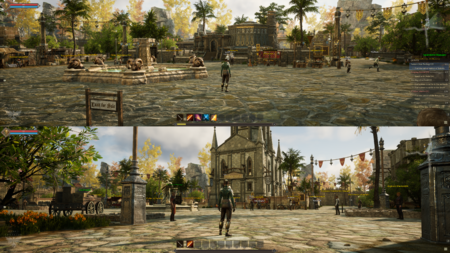
The layout and architecture within a Node’s development area are determined by influential race. For example, a stage 3 Node with the majority of player contribution being Py'rai would have a Py'rai village with Py'rai architecture. Most NPCs would be Py'rai elves, and offer questlines within the Py'rai narrative.[177] – Margaret Krohn
Each player’s contributed experience is flagged with their character race and other identifiers. When a Node advances, the race with the highest experience contribution determines the Node’s style and culture. This style and culture change can happen at every Node Stage. For example, if a Node advances to Level 2 - Encampment Stage and 51% of all experience was earned by Ren’Kai players, the Node will be a Level 2 Ren’Kai Node. If that same Node advances to a Level 3 - Village Stage Node, but the Py'Rai contributed 62% of all the experience earned, then the Node will be a Level 3 Py'Rai Node.[38] – Margaret Krohn
Node layout and style is determined by several factors:[191][192]
- The way that the node system is built is that they can exist across a spread of 18 biomes, but at the same time have to represent the cultural influence of these cultures that are intrinsically a part of a specific biome.[193] – Steven Sharif
- Environment (biome) and location of the node.[193][191][192]
- Nodes will adjust the local topography to fit the aesthetic and mechanical requirements of the node.[194]
- Currently the way that the platform system is set up, is it's capable of adjusting the topography of the node's footprint, regardless of the surrounding terrain. So the reason for that is we want to have flexibility in the presentation of the node's layout and how it is essentially both from an aesthetic standpoint as well as a mechanical standpoint with node sieges- how it's constructed and that construction should have the ability to take on a variance of different types of topography. So it shouldn't be dependent on the surrounding area. Now that's not to say that the surrounding area isn't going to have some influence over. So for example... we're experimenting a little bit with the platform tech and putting up a node up against the side of a mountain or on the edge of a cliff or something that has a beautiful vista. Those are things that we're going to test out obviously as we continue to work on the node tool and how that platform system works, but the idea is to have the node independent of the surrounding terrain.[194] – Steven Sharif
- Some parts are determined by the area it's in. Some parts are determined by the type it is. Some parts are determined by the race it is; and then the rest of it is determined by the mayor.[192] – Jeffrey Bard
- Race that contributed the highest percentage to the node's advancement will alter the racial appearance of its buildings, NPCs, and props.[195][196][191][38][192][197][198]
- All nodes, whether they're associated with a castle or associated with normal node structure, has cultural influences that replicate over to the buildings that are produced and the NPCs that are present.[200] – Steven Sharif
- The rest is determined by the node's mayor.[192]
- It should be possible for a node to complete several building projects within a mayor's one month term in office.[201]
- Q: How long would you say it will take players on average to fill/build up a node completely from wilderness to metropolis?
- A: It's one thing to get a node to a certain level: it's another thing to develop the node; and I can't really give you an on-average expectation, because there's a lot of variables at play. There's how many citizens does the node have attracted to it; what's the type of traffic that the node is attracting to it based on things like its tax rates, or the specialization that it chose to spec into, based on the building types it's chosen to build. All of those things are variables that can affect the quote-unquote "average build-out time" of a particular node. So it's difficult to give you an average when there's so many variables along those lines. But the idea is that if there is a particular project that players are interested in in developing based on the node stage, that they would have the ability to complete several of those projects as within a single term of a mayor; and a term of a mayor is one month.[201] – Steven Sharif
Player housing grace period
If a player's subscription runs out, there will be a grace period before player housing is lost.[176]
Visuals
2023-07-10 2023-07-08 2023-07-02 2023-07-01 2023-07-01 2023-07-01 2023-07-01 2023-07-01 2023-07-01 2021-04-15 2021-04-04 2020-05-30 2018-01-19 2018-01-19
Community guides
See also
References
- ↑ Video, May 25, 2017 (1:07).
- ↑ About Ashes of Creation.
- ↑ Livestream, May 4, 2018 (32:46).
- ↑ 4.00 4.01 4.02 4.03 4.04 4.05 4.06 4.07 4.08 4.09 4.10 4.11 4.12 Livestream, August 31, 2023 (15:51).
- ↑ 5.00 5.01 5.02 5.03 5.04 5.05 5.06 5.07 5.08 5.09 5.10 5.11 5.12 5.13 5.14 5.15 5.16 5.17 5.18 5.19 5.20 5.21 5.22 5.23 5.24 Node series part II – the Metropolis.
- ↑ Interview, July 9, 2023 (42:11).
- ↑

- ↑ 8.0 8.1 8.2 8.3 8.4 8.5 8.6 Interview, May 11, 2018 (50:47).
- ↑ 9.0 9.1 9.2 9.3 Steven Sharif - Clarification points from today’s stream.
- ↑ 10.0 10.1 10.2 10.3 10.4 10.5

- ↑ 11.00 11.01 11.02 11.03 11.04 11.05 11.06 11.07 11.08 11.09 11.10 11.11 11.12 11.13 11.14 11.15 11.16 11.17 11.18 11.19 11.20 11.21 11.22 11.23 11.24 11.25 11.26 11.27 11.28 11.29 11.30 11.31 11.32 11.33 11.34 11.35 11.36 11.37 11.38 11.39 11.40 11.41 11.42 11.43 11.44 11.45 11.46 11.47 11.48 11.49 11.50 Blog: Exploring the Boundless Opportunities of Freeholds.
- ↑ 12.0 12.1

- ↑ 13.0 13.1 13.2 13.3 13.4 Livestream, August 31, 2023 (22:32).
- ↑ Livestream, August 31, 2023 (18:13).
- ↑ 15.0 15.1 15.2 15.3 15.4 Livestream, June 26, 2020 (47:32).
- ↑ 16.0 16.1 16.2 16.3 16.4 16.5 16.6 16.7 16.8 16.9 Livestream, May 10, 2017 (30:53).
- ↑ 17.0 17.1 17.2 17.3 17.4 17.5 Interview, July 9, 2023 (38:14).
- ↑ 18.0 18.1

- ↑ 19.0 19.1 19.2 MMOGames interview, January 2017
- ↑ 20.0 20.1 20.2 20.3 Interview, July 8, 2020 (33:34).
- ↑ 21.0 21.1 21.2 21.3 21.4 21.5 Interview, July 8, 2020 (40:20).
- ↑ 22.0 22.1 22.2 22.3 22.4 22.5 22.6 22.7 22.8 Livestream, June 26, 2020 (45:32).
- ↑ 23.0 23.1 23.2 23.3 23.4 Video, May 31, 2020 (47:32).
- ↑ 24.0 24.1 Livestream, June 26, 2020 (53:20).
- ↑ 25.0 25.1 25.2 Interview, July 9, 2023 (41:22).
- ↑ 26.00 26.01 26.02 26.03 26.04 26.05 26.06 26.07 26.08 26.09 26.10 26.11 26.12 26.13 26.14 26.15 26.16 26.17 26.18 26.19 26.20 26.21 26.22 26.23 26.24 Development Update with Freehold Preview.
- ↑ 27.0 27.1 Interview, February 7, 2021 (42:41).
- ↑ 28.0 28.1 28.2 Livestream, October 30, 2020 (44:22).
- ↑ Livestream, May 5, 2017 (32:11).
- ↑ 30.0 30.1 30.2 30.3 30.4 30.5 30.6 30.7 30.8 Blog: Development Update with Village Node.
- ↑ Interview, March 27, 2020 (0:30).
- ↑ 32.0 32.1 32.2 Video, April 5, 2018 (41:48).
- ↑ Livestream, May 19, 2017 (53:24).
- ↑ 34.0 34.1 34.2 Interview, July 29, 2020 (17:26).
- ↑

- ↑ 36.0 36.1 Interview, May 11, 2018 (50:05).
- ↑ Livestream, August 31, 2023 (20:54).
- ↑ 38.00 38.01 38.02 38.03 38.04 38.05 38.06 38.07 38.08 38.09 38.10 38.11 38.12 Blog - Know Your Nodes - Advance and Destroy.
- ↑ Livestream, August 31, 2023 (2:22:01).
- ↑ Livestream, October 30, 2020 (1:01:00).
- ↑ Livestream, July 9, 2018 (27:12).
- ↑ Livestream, May 26, 2017 (44:52).
- ↑ 43.0 43.1 43.2 Livestream, June 26, 2020 (58:32).
- ↑ 44.0 44.1 44.2 44.3 44.4 Livestream, June 26, 2020 (51:58).
- ↑ 45.0 45.1 45.2 Livestream, May 19, 2017 (26:40).
- ↑ 46.0 46.1 46.2 46.3 Livestream, April 30, 2021 (1:12:33).
- ↑ 47.0 47.1 Livestream, June 30, 2023 (1:19:01).
- ↑ Livestream, July 30, 2021 (1:14:33).
- ↑ Livestream, June 28, 2019 (1:23:31).
- ↑

- ↑ 51.0 51.1 51.2 Livestream, June 30, 2023 (1:24:16).
- ↑ Livestream, January 29, 2021 (1:13:04).
- ↑ Livestream, February 9, 2018 (51:57).
- ↑ 54.0 54.1

- ↑ 55.0 55.1

- ↑ 56.0 56.1 56.2 Livestream, June 30, 2023 (1:49:00).
- ↑ 57.0 57.1 57.2 Livestream, November 19, 2021 (54:26).
- ↑ 58.0 58.1 58.2 58.3 58.4 58.5 Livestream, August 28, 2020 (2:04:00).
- ↑ 59.0 59.1 59.2 59.3 59.4 59.5 Livestream, May 19, 2017 (28:04).
- ↑ Livestream, October 16, 2017 (59:39).
- ↑ 61.0 61.1 61.2 61.3 Interview, July 9, 2023 (1:50:50).
- ↑ Livestream, May 29, 2020 (36:29).
- ↑ Livestream, June 30, 2023 (9:09).
- ↑ 64.0 64.1 Video, June 30, 2023 (5:41).
- ↑ 65.0 65.1 65.2 65.3 65.4 65.5 Livestream, June 30, 2023 (1:12:07).
- ↑ 66.0 66.1 66.2 66.3 66.4 66.5 66.6 66.7 66.8 66.9 Livestream, June 30, 2023 (14:09).
- ↑ 67.0 67.1 67.2 67.3 67.4 67.5 67.6 67.7 Video, June 30, 2023 (21:22).
- ↑ 68.0 68.1 Livestream, April 29, 2022 (1:03:44).
- ↑ 69.0 69.1 69.2 69.3 69.4 69.5 69.6 69.7 69.8 69.9 Livestream, May 19, 2017 (32:23).
- ↑ 70.0 70.1 70.2 70.3 70.4 Livestream, June 30, 2023 (1:15:34).
- ↑ 71.0 71.1 71.2 71.3 71.4 71.5 Livestream, June 30, 2023 (13:10).
- ↑ 72.0 72.1 72.2 72.3 72.4

- ↑ 73.0 73.1 73.2 Podcast, July 15, 2023 (11:21).
- ↑ 74.0 74.1

- ↑

- ↑ 76.0 76.1

- ↑ 77.0 77.1 77.2 Podcast, July 15, 2023 (15:14).
- ↑

- ↑ 79.0 79.1 Interview, July 9, 2023 (19:56).
- ↑ 80.0 80.1 80.2 Interview, July 8, 2020 (45:23).
- ↑ 81.0 81.1 81.2 Livestream, October 16, 2017 (56:42).
- ↑ 82.0 82.1

- ↑ 83.0 83.1 Livestream, June 30, 2023 (30:21).
- ↑ 84.0 84.1 84.2 84.3 84.4 84.5 84.6 Livestream, June 30, 2023 (1:45:22).
- ↑ 85.0 85.1 85.2 85.3 Livestream, June 30, 2022 (1:09:29).
- ↑ Livestream, February 25, 2022 (1:12:27).
- ↑ Podcast, April 11, 2021 (40:20).
- ↑ Interview, March 27, 2020 (9:00).
- ↑ Livestream, May 5, 2017 (34:15).
- ↑ 90.0 90.1 Livestream, June 30, 2022 (1:08:02).
- ↑ 91.0 91.1 91.2 Livestream, June 30, 2023 (26:23).
- ↑ Livestream, April 7, 2023 (37:56).
- ↑ Interview, July 9, 2023 (49:48).
- ↑ 94.0 94.1 Livestream, January 31, 2024 (1:24:57).
- ↑ 95.0 95.1

- ↑ 96.0 96.1 Livestream, July 28, 2023 (1:33:58).
- ↑ 97.0 97.1 97.2 97.3 97.4 Livestream, June 30, 2023 (16:14).
- ↑

- ↑ 99.0 99.1 Livestream, June 30, 2023 (1:36:52).
- ↑ 100.0 100.1 Livestream, June 30, 2023 (18:45).
- ↑ 101.0 101.1 101.2 101.3 Interview, July 9, 2023 (29:53).
- ↑ Livestream, June 26, 2020 (1:52:33).
- ↑ Livestream, May 9, 2018 (40:24).
- ↑

- ↑ 105.0 105.1 Interview, July 9, 2023 (32:53).
- ↑

- ↑

- ↑ Livestream, May 26, 2017 (34:21).
- ↑

- ↑ Livestream, June 30, 2023 (12:11).
- ↑ 111.0 111.1 111.2 111.3 111.4 111.5 111.6 Livestream, April 7, 2023 (31:49).
- ↑ 112.0 112.1 Livestream, May 24, 2017 (9:58).
- ↑ Video, June 30, 2023 (15:34).
- ↑ Livestream, June 28, 2019 (1:09:22).
- ↑ 115.0 115.1 115.2

- ↑ 116.0 116.1 116.2 116.3 Interview, July 9, 2023 (54:46).
- ↑ 117.0 117.1 117.2 117.3 117.4

- ↑ 118.0 118.1 118.2 118.3 Livestream, August 28, 2020 (2:14:06).
- ↑ Livestream, June 30, 2023 (22:05).
- ↑ 120.0 120.1 Livestream, November 30, 2020 (57:50).
- ↑ 121.0 121.1

- ↑ Livestream, May 26, 2017 (44:11).
- ↑ 123.0 123.1 Livestream, June 30, 2023 (7:36).
- ↑ 124.0 124.1 Livestream, May 29, 2020 (41:27).
- ↑ 125.0 125.1 Livestream, June 30, 2023 (1:21:48).
- ↑ 126.0 126.1 Interview, July 9, 2023 (33:55).
- ↑

- ↑

- ↑

- ↑ 130.0 130.1 Livestream, June 30, 2023 (33:26).
- ↑

- ↑ 132.0 132.1 132.2 Interview, July 9, 2023 (53:08).
- ↑ Interview, May 11, 2018 (28:21).
- ↑

- ↑

- ↑

- ↑ 137.0 137.1 Livestream, May 17, 2017 (1:03:23).
- ↑ 138.0 138.1 138.2 Livestream, July 28, 2023 (1:26:16).
- ↑ Livestream, January 18, 2018 (31:05).
- ↑ Livestream, December 23, 2021 (1:29:27).
- ↑ Video, May 31, 2020 (38:50).
- ↑ Livestream, May 19, 2017 (33:57).
- ↑ 143.0 143.1 143.2 143.3 143.4 143.5 143.6 143.7 Video, May 31, 2020 (47:32).
- ↑

- ↑ Livestream, October 31, 2019 (36:20).
- ↑ 146.0 146.1 Livestream, November 22, 2019 (16:56).
- ↑ 147.0 147.1 147.2 147.3 147.4 147.5 147.6 147.7 Livestream, March 31, 2022 (1:13:00).
- ↑ 148.0 148.1 148.2 148.3 Interview, July 8, 2020 (57:46).
- ↑ Forums - Livestream Q&A 2022-08-26.
- ↑ 150.0 150.1 150.2 150.3 150.4 Livestream, August 31, 2023 (57:23).
- ↑ Interview, July 9, 2023 (1:32:45).
- ↑ 152.0 152.1 Livestream, November 22, 2019 (17:59).
- ↑ Interview, July 9, 2023 (1:36:24).
- ↑ Livestream, October 14, 2022 (52:31).
- ↑ Podcast, September 29, 2021 (14:21).
- ↑ Livestream, April 30, 2020 (1:14:44).
- ↑

- ↑ 158.0 158.1 158.2 Livestream, June 26, 2020 (1:02:12).
- ↑ 159.0 159.1 159.2 159.3 159.4 159.5 159.6 159.7 159.8 Livestream, July 18, 2017 (40:14).
- ↑ 160.0 160.1 160.2 160.3 160.4 Livestream, November 17, 2017 (47:10).
- ↑ Livestream, March 26, 2021 (59:21).
- ↑ Livestream, May 19, 2017 (29:34).
- ↑ Livestream, June 30, 2023 (1:39:22).
- ↑ 164.0 164.1 Livestream, June 26, 2020 (1:00:57).
- ↑ 165.0 165.1

- ↑ Livestream, June 26, 2020 (54:03).
- ↑ 167.0 167.1 167.2 167.3 Livestream, May 12, 2017 (55:01).
- ↑ 168.0 168.1 Livestream, June 26, 2020 (53:41).
- ↑ Livestream, May 12, 2017 (52:01).
- ↑ Livestream, June 26, 2020 (56:08).
- ↑ Livestream, June 30, 2023 (1:20:20).
- ↑ 172.0 172.1 Livestream, May 30, 2019 (1:23:41).
- ↑

- ↑ 174.0 174.1 Livestream, August 31, 2023 (24:13).
- ↑ Livestream, July 28, 2023 (1:29:07).
- ↑ 176.0 176.1 Livestream, May 24, 2017 (42:22).
- ↑ 177.0 177.1 177.2 Blog - Know Your Nodes - The Basics.
- ↑ Livestream, October 16, 2017 (14:12).
- ↑ Video, August 31, 2023 (33:07).
- ↑ The mighty beard!
- ↑ Livestream, May 29, 2020 (36:18).
- ↑ Video, June 30, 2023 (10:24).
- ↑ Livestream, November 17, 2017 (26:22).
- ↑ 184.0 184.1 184.2 184.3 Livestream, January 27, 2023 (1:35:45).
- ↑ Livestream, May 24, 2017 (29:54).
- ↑ Livestream, May 29, 2020 (38:04).
- ↑ 187.0 187.1 187.2 Livestream, January 28, 2022 (1:13:55).
- ↑ Livestream, May 22, 2017 (56:31).
- ↑ Livestream, June 25, 2021 (1:31:04).
- ↑ 190.0 190.1 Livestream, August 17, 2018 (10:54).
- ↑ 191.0 191.1 191.2 Livestream, October 30, 2020 (39:17).
- ↑ 192.0 192.1 192.2 192.3 192.4 192.5 Livestream, September 27, 2018 (53:06).
- ↑ 193.0 193.1 Livestream, February 25, 2022 (41:00).
- ↑ 194.0 194.1 Livestream, February 26, 2021 (1:12:18).
- ↑ Livestream, March 31, 2022 (4:57).
- ↑ Podcast, April 11, 2021 (29:47).
- ↑ Interview, May 11, 2018 (54:34).
- ↑ Livestream, May 26, 2017 (21:23).
- ↑ Podcast, April 11, 2021 (23:36).
- ↑ 200.0 200.1 Interview, May 11, 2018 (47:27).
- ↑ 201.0 201.1 Livestream, July 29, 2022 (1:13:09).






